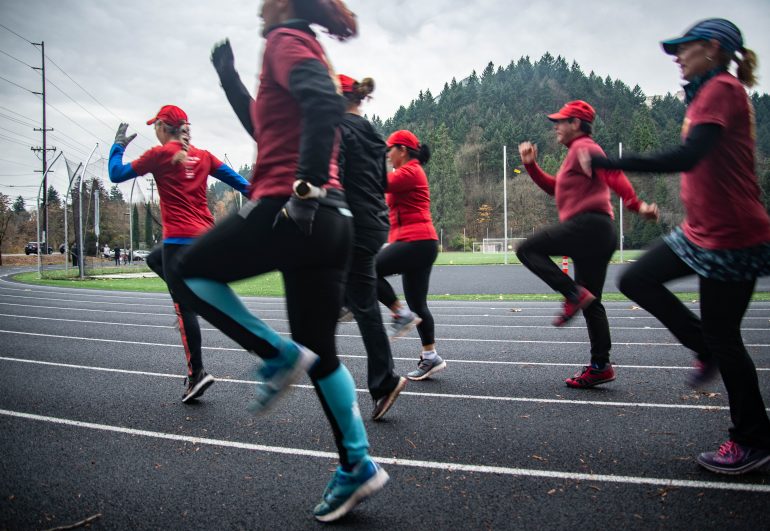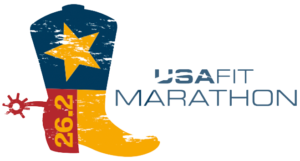Track Workouts

Track workouts: 6am on Tues at Duniway park starting week 14!
HILLS, INTERVALS and TEMPO: Practice Fast to Get Fast
Training for a marathon, our goal is for the body to ADAPT to the STRESS (workouts) with improvement, but without injury or overtraining. Each workout has a SPECIFIC stress (movement, distance, speed or time) in order to produce a specific result. You can’t practice your baseball swing to complete a marathon! You need to walk or run, at the distance and pace needed for your goal! This is called specificity of training.
Put very simply, going faster will help you get faster and stronger, while making your easy paces feel easier. More particularly, it will help develop your muscles, connective tissue (bone, tendons, ligaments), nervous system (coordination), cardiovascular system (heart and blood vessels), energy systems (use of fuel by cells), mental fitness, and economy of movement.
- If you are a novice runner or walker, or recovering from injury: you don’t NEED to do the“speed” workouts. It’s okay to just substitute the same total time and do an easy tomoderate walk or run.
- If you are experienced, not injured, and looking to reach a new goal, stepping up yourtraining with hill / interval and tempo workouts (as well as being very consistent in doingyour weekly walk/runs) can help you improve.
- “Effort” or hard days should never be back to back. This includes your long run/walk. If youneed to adjust your schedule, just make sure an easy or rest day goes between a Long day, Hill / Speed / Interval day, and Tempo day.
HILLS: often called “speedwork in disguise;” this gets you stronger (muscles, heart) with less stress on connective tissue from pounding. It’s a great chance to work on your form.
- Pick a moderate-grade hill; Warm up (WU) for 10 min (ideally on the way there); go uphill
moderately hard for 1-3 minutes; easy pace (jog for runners) on the way down; Repeat; Cool
down (CD) for the last 10 minutes.
- Sample: 45/hill = 10 WU + 25 min hill repeats + 10 CD. I find slightly less than half the “hill repeat” time is spent going uphill, say 12 min = 12 x 1min/ easy down; 8 x 90s; 6 x 2’; or 4 x 3’. Each week, you can increase how long you go uphill or increase the # of reps. Hint: I like going up for at least 90 seconds, which means fewer reps (and less counting).
- Alternately you can pick a hilly route, with about the same amount of up and down, and work the uphills, while relaxing on downhills.
- Note, we are focused on endurance and VO2 max improvement. There are many other types of hill workouts. Hill “sprints” are different: they work running economy, muscle fiber recruitment and form, but are quite demanding, and require full recovery (3-5x 10-20 sec sprint up / walk down). Downhill strides (e.g. 30s fast/ 2 min easy) train eccentric muscle contraction (work during lengthening) and are a powerful training stimulus, but can make your quads quite sore. I only use them if training specifically for a downhill race.
FARTLEK: “Speed Play” in Swedish; an unstructured blend of different paces (faster and slower). Typically, alternating an easy pace with moderately hard surges, with (almost) full recovery before the next surge. Fartleks can be done less formally, using landmarks (“go faster for 1 block” or “to the 2nd telephone pole”), or more formally with a watch (fast for 30 sec-3 min). Workouts in our schedule include: 30 fast /30 sec easy; 60/60sec, etc. Make sure to include a 10 minute warm up and cool down. You can be on mostly flat road/ sidewalk or at a track. The faster portion is NOT an all-out SPRINT! Think “moderately hard” or “surge” so you can sustain the same pace from the 1st surge to the last.
Whether walking or running, this is a fantastic time to think about your form (shoulders relaxed, arms swinging at 90-deg near your sides, hands not crossing over your center line, stance tall, gaze ahead, feet landing quietly under you without over-striding).
INTERVALS aka “Track:” Technically, Interval workouts consist of faster segments (“repeats” or “repetitions”) followed recovery “intervals.” The speed and distance of both the “repeats” and “recovery” vary according to the workout goals. In training for a half or marathon, these are NOT sprinting workouts. The goal is to work on your form, consistent pacing (from the first to the last repetition), mental toughness (keep going when you are tired), muscle fiber recruitment, endurance, etc. I usually start out just slightly easier on my first repeat, and use the lap function on my watch to time my fast AND slow segments. I can tell I started too fast if I’m needing more time to finish the repeats, or to recover between them. The goal is to feel like you could do 1-2 more if you needed to at the end. If you are a runner, try to jog slowly between repeats. If you need to walk, you might be pushing too hard.
A typical track workout:
1. Warm up at easy pace x 10 min. * Dynamic, Drills and Strides not required but
recommended.
• *Dynamic warmup (e.g. torso twist, lunges, leg swings, hurdlers, heel/toe walks)
• *Drills (march/skip, high knees, butt kicks, grapevine, quick feet)
• *Strides: 15-20 sec long, with 5 sec gradual acceleration to 85% of max (think “fast and
smooth”), then gradual deceleration; 3-5x total. Think about your form.
2. Interval workout, e.g. 5-6x 800m/400m (or time-based: 5x4min/2 min). See the schedule.
3. Cool down (easy pace) x 10 min
4. Optional: do a few strength exercises (lunges, squats, planks, bridge) and gentle stretches at the end.
5. Recovery snack in the car on the way home
TEMPO: A tempo workout is defined many different ways, depending on the coach and plan. Most often the pace is described as “comfortably hard”; or a pace you could sustain (all-out) in a one-hour race (for an average runner, perhaps 10k to 10-mile race pace). You should be able to speak in phrases or short sentences. Tempo pace is held typically for 10-30 min in the middle of the workout (sometimes only for 5 min at the beginning of training). Example: 45/ tempo = 10 WU + 25 tempo + 10 CD. Tempo workouts improve endurance, especially raising the lactate threshold (rate at which lactate can be cleared / used as fuel before accumulating) and is a key workout in half/marathon training. If done too fast, it won’t work the lactate threshold, and you will be too tired to consider continuing more than 20-30 min. If that’s the case, slow down a bit next time, and save faster speeds for fartleks, strides and intervals.



